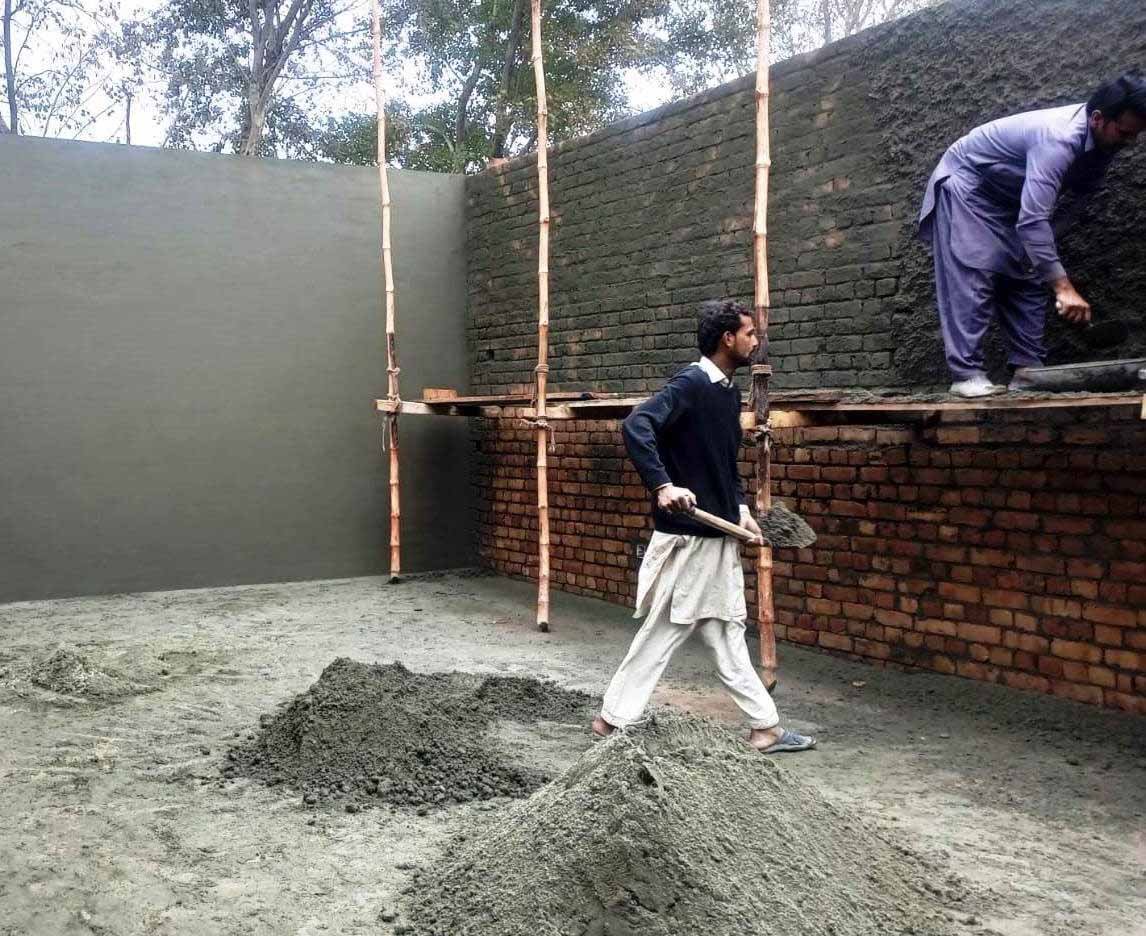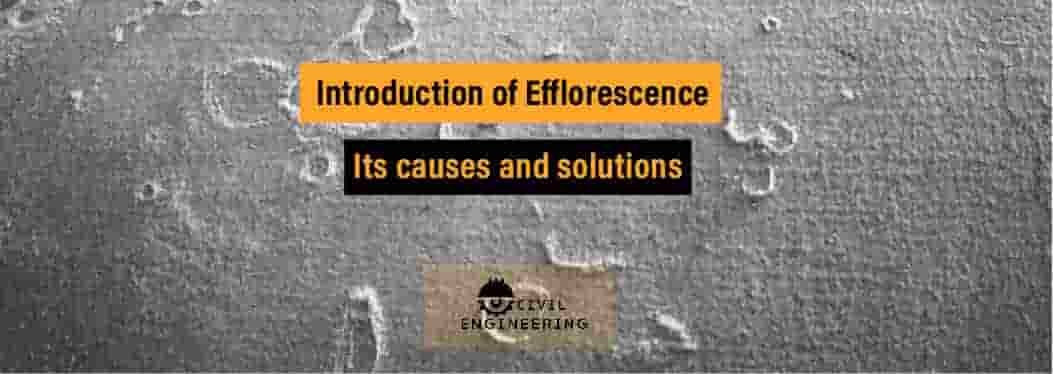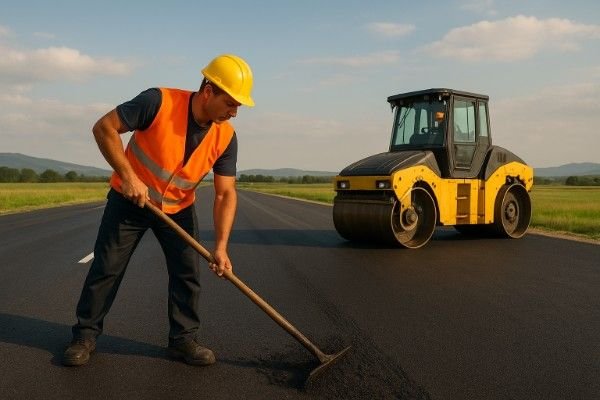Table of Contents
Overview (Plaster)
Plastering or plaster is the process of protecting and decorating construction work (such as brick masonry, block work and concrete) with a mixture of cement (lime or mud), sand and water. This mixture is applied to the surface of walls, ceilings, or partitions. Plaster has different types like cement, lime, mud and gypsum plaster. Cement plaster & gypsum plaster is currently using and mud plaster is an old type of plastering.
Cement Plaster
Cement plaster is most common used type of plaster and it is also the most durable type. Cement plaster is prepared by mixing of cement, sand and water in specified ratios. Standard ratio of cement and sand for plastering is 1:4 (1 part cement: 4 part sand) but generally 1:3,1:4,1:5 and 1:6 ratio of cement and sand is also using.
Cement Plastering Procedure
Plaster shall be composed of cement and washed sand, mixed in the proportions specified .The plaster shall be applied in one or two coats work, following steps is involved in cement plastering procedure:
- Surface Preparation
- Cleaning of surface: Surface of brick, block, or concrete work should be cleaned of any dust, grease, oil, or loose material.
- Water curing of surface: Surface should be washed and wetted with water to prevent the wall from absorbing moisture from the Plaster mix.
- Slurry of cement and water is brushed onto the surface before plastering to act as a bonding layer.
- Mixing the Cement Plaster
- Materials: Cement, sand, and water are mixed in the specified ratio (commonly 1:4 or 1:6 depending on the type of plaster required).
- Mixing Process: Combine the dry cement and sand thoroughly before adding water. Water is added gradually to achieve a smooth, workable consistency.
- Applying the First Coat (Scratch Coat)
- Thickness: First layer of plaster, generally 10-12 mm or 0.5 inch thick, is applied to the wall using a trowel.
- Scratching: After the first coat has partially dried, it is roughened or scratched using a trowel or wire comb to provide a base for the next layer.
- Curing: First coat should cure for at least 24 hours, with regular watering to prevent it from drying too quickly.
- Applying the Second Coat (Finishing Coat)
- Thickness: The second layer or finishing coat of plastering is applied over the scratched coat. This layer is usually 6-8 mm and if only 1 layer is applied then thickness of plaster should not be less that 12 mm or 0.5 inch and not more than 20 mm or 0.10 inch.
- Smoothing: The surface should be leveled and smoothed by using wooden or metal float, ensuring an even, uniform finish. Corners and edges are carefully finished.
- Finishing and Curing
- Once the final coat has been smoothed, it is allowed to set for a few hours. Afterward, the surface is continuously cured by sprinkling water or covering with wet hessian cloths to retain moisture for proper hydration.
- Curing of Plaster: Plaster should be cured with water for 7-10 days. This is essential to prevent cracking and to ensure proper strength development.
Mud Plaster
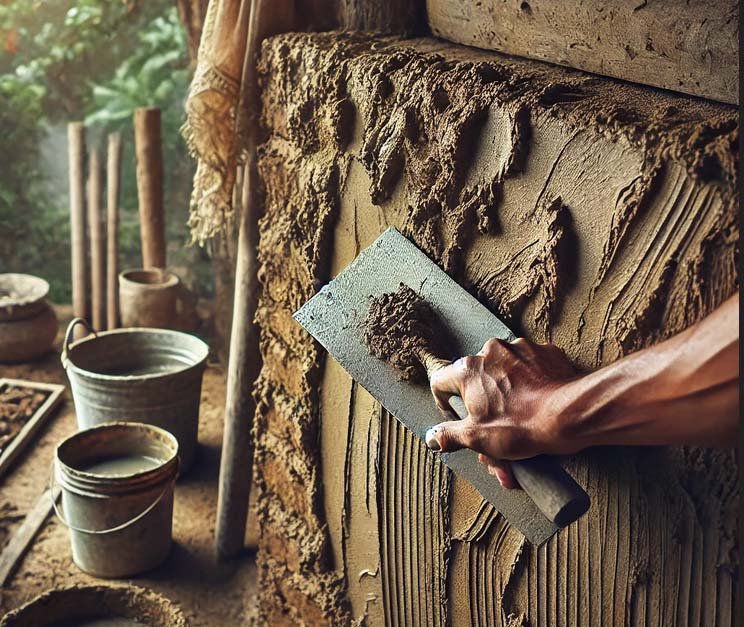
Mud plaster shall be composed of stiff clay to which shall be added equal bulk of chopped straw. The Clay, which may if required, contain a small quantity of sand not exc 5%, shall be laid out in stacks not exc 300 mm high and saturated with water. The water is allowed to stand for not less than three days. During this period, water is added as required, to ensure complete saturation. The binding material shall then be added and the mixture well puddled and left for two days to soak. It will then be thoroughly mixed (water is added, if required) to the consistency of stiff mortar. The mud plaster shall be floated smooth and level, and when dry, will be given a coat of leeping 3 mm thick as given below.
- Leeping shall be made with a mixture of clay and cow dung in equal parts and trowelled or floated smooth. A small quantity of Sand may be added to the mixture, if so ordered.
- Leeping must be free from seeds, grass, straw and other impurities.
Gypsum Plaster
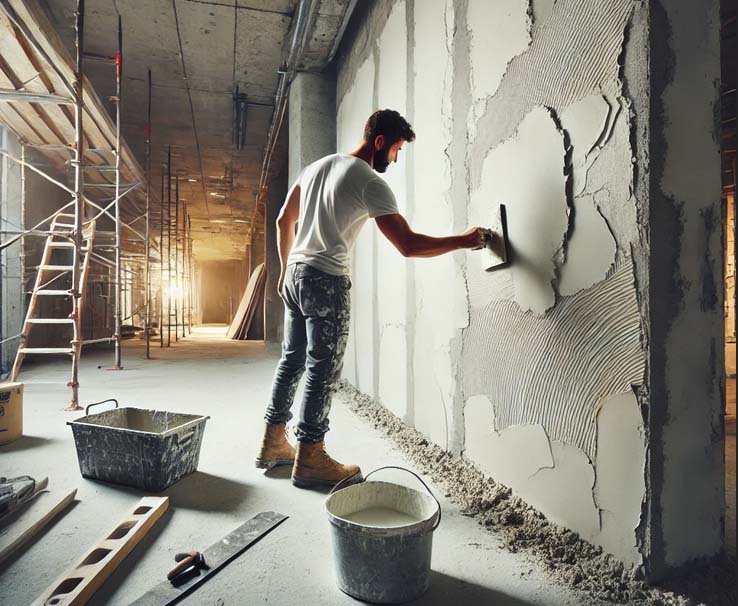
Gypsum powder shall be gradually added to water @ approx one bag (40 Kg) to 24 lit of water. It should be left undisturbed for about 3 mins and then mixed by hand or by using suitable drill. For hand mixing, one bag should be mixed at a time whereas upto 3 bags may be mixed simultaneously for drill mixing. The mixing shall be done for about 3 min to obtain a mortar of good consistency i.e, which does not flow when applied on walls. Immediately before applying plaster, the area being plastered shall be wetted.
- After the initial spreading on wall, the surface must be leveled using straight edge, before the start of initial set, which is about 65 mins. The final setting is about 90 mins, when the final trowel is to be completed.
- Gypsum plaster is usually a One Coat plaster, which combines the function of both backing and finishing plaster. The coverage will vary greatly depending on the nature of the wall and thickness of application, but, on an avg 3 bags of Gypsum powder will give 9.29 Sqm of 13mm thick plaster.
- Any instructions of workmanship, issued by the manufacturer, shall take precedence and will be followed.
Properties of Good Quality Plaster Materials
- Cement:The cement shall be Ordinary Portland, Normal Setting of any brand, complying in all respects with BS No. 12, unless, otherwise, specified to be of any particular quality.
- Sand: Sand should have a shiny and clear crystal color. Sand should be free from dust and other waste material. The sand should be free from salts because salty sand causes efflorescence on walls.
- Clay: Mud shall be composed of stiff Clay. Clay should possess good plasticity, allowing it to be easily molded and spread on surfaces.
- Chopped Straw / Fiber: Chopped straw not less than 25mm long, fiber or other similar and approved long binding material should be used.
- Water:The quality of mixing water shall be determined by AASHTO methods of sampling and testing designation T-26. Water used in plaster shall be clean and free from injurious amount of acids, alkalis, salts, organic material or substances deleterious to plaster. It shall be free from oil and shall neither contain more than 1,000 ppm of Chlorides nor more than 1,300 ppm of Sulphates (SO4).
Important Points while doing Plaster Work
While performing plaster work, ensure the following:
- All irregularities in wall shall be dubbed out with mortar of the same specification and consistency as the plaster coat.
- Cleaning the surface is very important because, without cleaning, plaster cannot bond properly with the surface.
- Plaster mix should only be prepared for use within the next 30 minutes, as it starts hardening after this time.
- Curing is crucial to prevent cracks due to quick drying.
- Try to avoid applying very thin or very thick layers of plaster.

